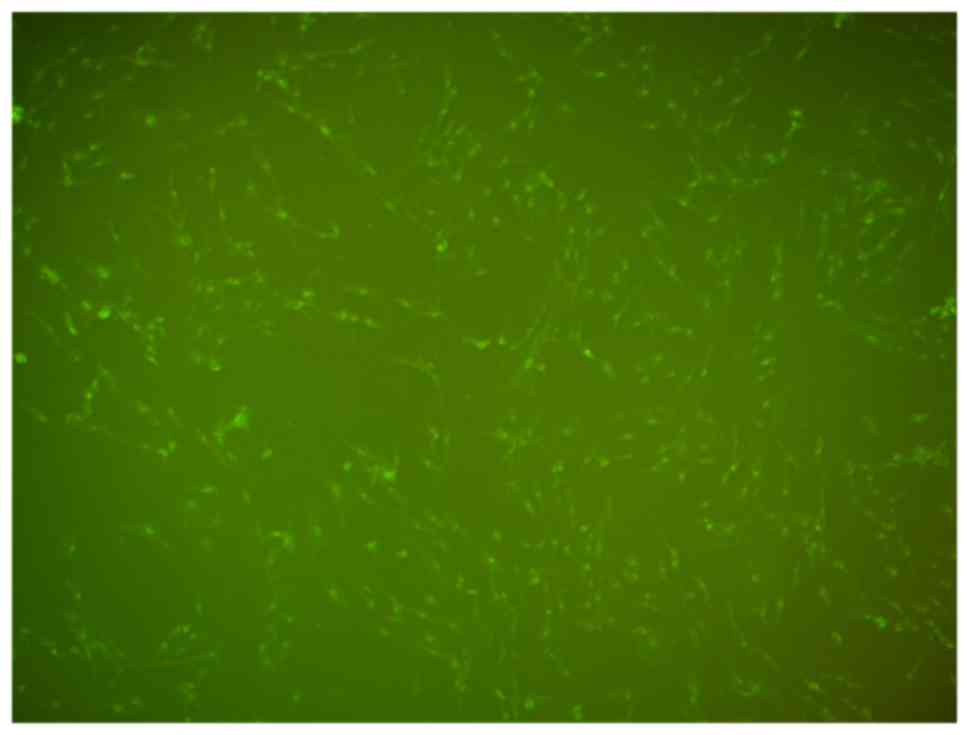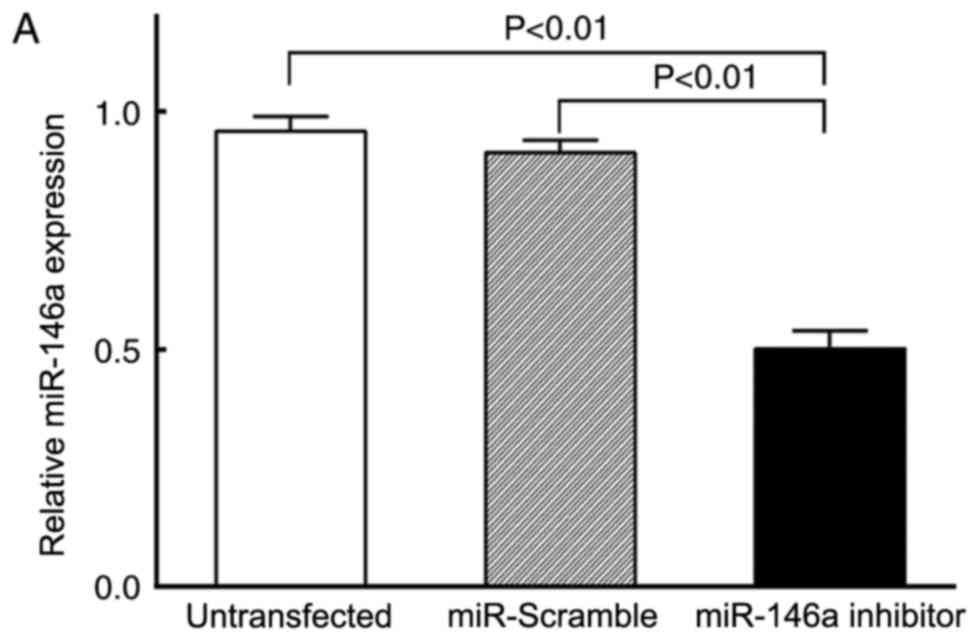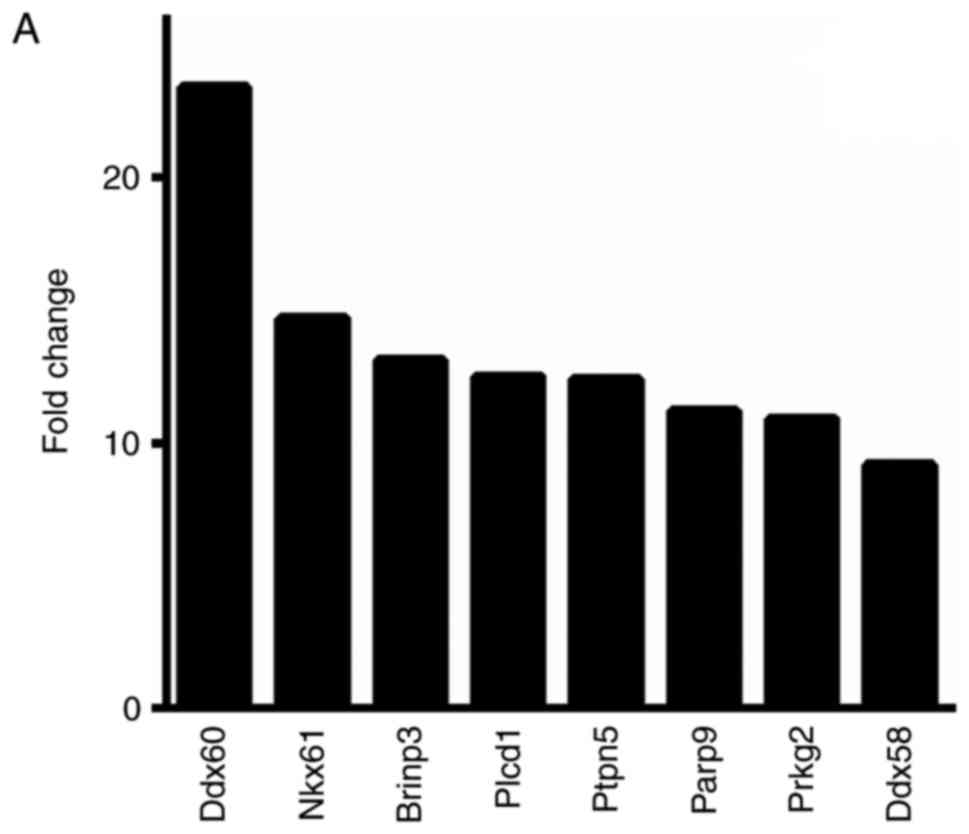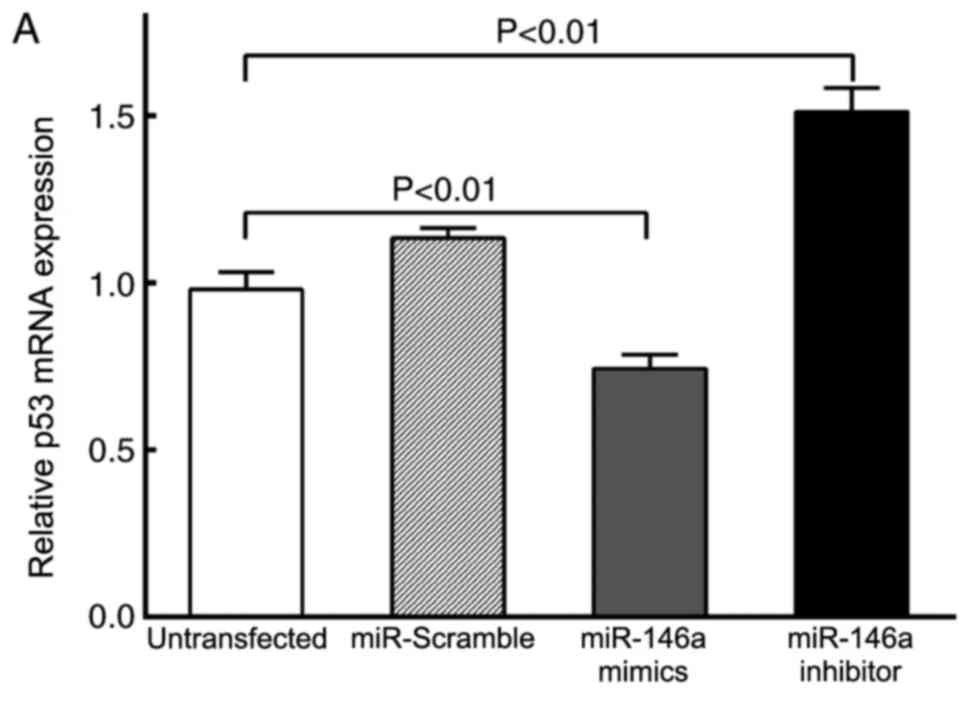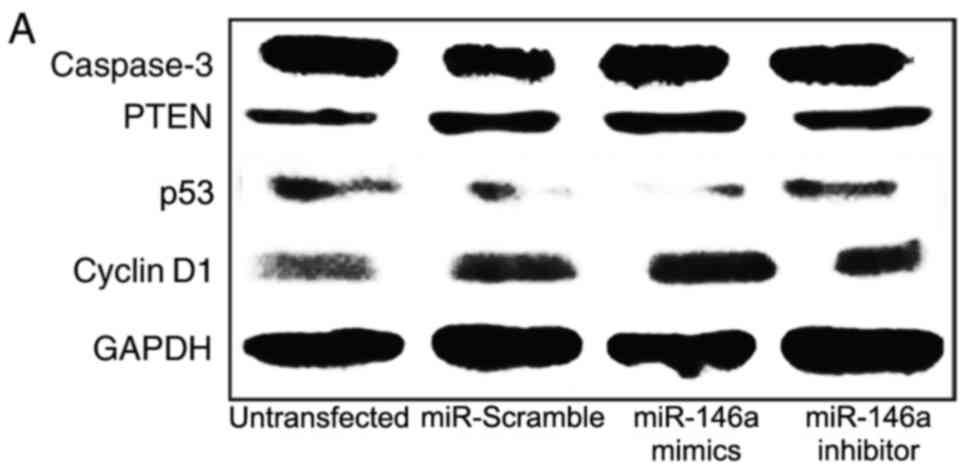MicroRNA‑146a promotes the proliferation of rat vascular smooth muscle cells by downregulating p53 signaling
- Authors:
- Published online on: September 12, 2017 https://doi.org/10.3892/mmr.2017.7477
- Pages: 6940-6945
Abstract
Introduction
Vascular neointimal remodeling is a crucial pathological process in proliferative cardiovascular diseases, such as atherosclerosis and restenosis following angioplasty (1). Vascular smooth muscle cells (VSMCs) are not terminally differentiated; their phenotypic transition from the differentiated state to the dedifferentiated state induces alterations in vascular biology and subsequently leads to vascular neointimal remodeling (2). However, the molecular mechanisms behind this pathological process have not been fully determined.
Endogenous, non-coding microRNAs (miRNAs) negatively regulate the expression of greater than one-third of human genes at the post-transcriptional level by degrading or inhibiting the translation of their specific target genes (3). Certain miRNAs determine cell fate and tissue homeostasis, including VSMCs biology and vascular remodeling. Identification of these specific miRNAs may aid in the discovery of novel targets in the prevention and treatment of proliferative cardiovascular diseases (4,5).
miRNA (miR)-146a was the first small RNA to be discovered that was demonstrated to be involved in the regulation of the immune system, mainly associated with the development of rheumatoid arthritis, cancer and sepsis (6). A previous study demonstrated that the level of miR-146a expression was significantly higher in the peripheral blood mononuclear cells of patients with acute coronary syndrome (7). miR-146a may promote differentiation and functions of type 1 T helper (Th1) cells, and may be involved in immune regulation in patients with coronary heart disease (7). The level of miR-146a expression was reported to be significantly upregulated in the carotid artery following carotid artery balloon injury, which suggested that miR-146a may be involve in the pathophysiology of restenosis following balloon injury (8). A recent study also revealed that miR-146a was involved in atherosclerosis in apolipoprotein E-deficient (ApoE−/−) rats (9). Our previous study demonstrated that the level of miR-146a was significantly increased during VSMC proliferation, and that miR-146a promoted the proliferation and migration of VSMCs and inhibited their apoptosis, but its mechanisms remains unclear (10).
The present study aimed to explore the target genes of miR-146a and the signaling pathways that may be involve in promoting VSMC proliferation to gain a better understanding of its role in cardiovascular diseases.
Materials and methods
Ethics statement
This study was carried out in strict accordance with the recommendations in the Guide for the Care and Use of Laboratory Animals of the National Institutes of Health. The protocol was approved by the Animal Ethics Committee of the Shenzhen People's Hospital (Shenzhen, China); all efforts were made to minimize suffering.
Rat VSMC culture and miR-146a interference
Male Sprague-Dawley rats (8 weeks-old; 150±20 g; n=3) were purchased from Guangdong Medical Laboratory Animal Center (Foshan, China) and housed in specific pathogen-free animal room on 12-h light/dark cycle at 40–70% humidity and 22±2°C with access to food and water ad libitum. Primary VSMCs were obtained and isolated from the thoracic aortic media of SD rats (10). The VSMCs were divided into four groups: i) miR-146a mimics group; ii) miR-146a inhibitor group; iii) miR-Scramble negative control group; and iv) untransfected VSMC control group. miR-146a inhibitors were labeled with 6-carboxyfluorescein. Cells (1×105 cells/ml) in miR-146a mimics group, miR-146a inhibitor group and negative control group were transfected with miR-146a mimics (50 nmol/l; Shanghai GenePharma Co., Ltd., Shanghai, China), miR-146a inhibitor (siRNA) (50 nmol/l; Shanghai GenePharma Co., Ltd.) or miR-Scramble negative control (50 nmol/l; Shanghai GenePharma Co., Ltd.), respectively, using Lipofectamine 2000 (Invitrogen; Thermo Fisher Scientific, Inc., Waltham, MA, USA) in an incubator containing 5% CO2 at 37°C for 5 h. PBS (Gibco; Thermo Fisher Scientific, Inc.) was added at the same equivalent dosage to normal VSMC group. The medium was replaced with Dulbecco's modified Eagle's medium (Gibco; Thermo Fisher Scientific, Inc.) 5 h post-transfection, and transfection efficiency was observed under a fluorescence microscope. VSMCs were subsequently incubated for 48 h in the incubator containing 5% CO2 at 37°C prior to further experiments.
Reverse transcription-quantitative polymerase chain reaction (RT-qPCR)
Following incubation at 37°C for 48 h post-transfection, total RNA of VSMCs (3×105 cells/ml) was extracted using the miRNeasy Mini Kit (Qiagen GmbH, Hilden, Germany). The cDNA was synthesized using a PrimeScript Reagent Kit (Takara Bio, Inc., Otsu, Japan). RT-qPCR was accomplished using the ABI PRISM 7900 Sequence Detection System (Applied Biosystems; Thermo Fisher Scientific, Inc.) with the SYBR Premix Ex Taq Kit (Takara Bio, Inc.). Primer sequences were as follows: miR-146a, forward 5′-TGAGAACTGAATTCCATGGGTT-3′, reverse 5′-GGCCAACCGCGAGAAGATGTTTTTTTTT-3′; caspase-3, forward 5′-GCTGGACTGCGGTATTGAGA-3′, reverse 5′-CCATGACCCGTCCCTTGA-3′; phosphatase and tensin homology (PTEN), forward 5′-AGACCATAACCCACCACAGC-3′, reverse 5′-TTACACCAGTCCGTCCTTTCC−3′; p53, forward 5′-AGATTGGGGAATGGGTTGG-3′, reverse 5′-GATAGAATCTTACAGGCGGTGG-3′; cyclin D1, forward 5′-GCGTACCCTGACACCAATCTC-3′, reverse 5′-CTCTTCGCACTTCTGCTCCTC−3′; U6, forward 5′-CTCGCTTCGGCAGCACA-3′, reverse 5′-ACGCTTCACGAATTTGCGT-3′. PCR conditions were as follows: One cycle at 95°C for 30 sec, 40 cycles at 95°C for 5 sec and one cycle at 60°C for 30 sec. Relative expression levels of miR-146a, caspase-3, PTEN, p53, cyclin D1 and U6 (internal control) were calculated by using SDS 2.1.1 software (Applied Biosystems; Thermo Fisher Scientific, Inc.). All primers were synthesized by Sangon Biotech Co., Ltd. (Shanghai, China). All Experiments were performed according to the manufacturer's protocol.
VSMC proliferation
VSMCs seeded (1×104 cells/well) in the 96-well plate were cultured in the incubator containing 5% CO2 at 37°C for 24 h. The cells were transfected with miR-146a inhibitor (50 nM), miR-Scramble control (50 nM) or PBS for 5 h at 37°C. The proliferative properties of the VSMCs were measured using the Cell Counting Kit-8 (Dojindo Molecular Technologies, Inc., Kumamoto, Japan) and cell counting was performed 48 h after VSMC transfection. The absorbance was measured at 450 nm with a reference wavelength at 650 nm using microplate reader (Bio-Rad Laboratories, Inc., Hercules, CA, USA). The number of VSMCs was counted using a hemocytometer under an IX51 light microscope (Olympus Corporation, Tokyo, Japan). All experiments were performed six times.
Microarray expression profiling analysis
VSMCs (1×105 cells/ml) cultured in an incubator containing 5% CO2 at 37°C were divided into miR-146a inhibitor group and miR-146a scramble group (n=3 samples/group). VSMCs were transfected with miR-146a inhibitor (50 nmol/l) or miR-146a scramble (50 nmol/l) in 5% CO2 at 37°C for 5 h at room temperature prior to further incubation in 5% CO2 at 37°C for 48 h. Total RNA was isolated from VSMCs using TRIzol reagent (Invitrogen; Thermo Fisher Scientific, Inc.) according to manufacturer's protocol. Gene profile was scanned using an Agilent DNA Microarray Scanner (Agilent Technologies, Inc., Santa Clara, CA, USA) and data were collected using Agilent Feature Extraction software (v11.0.1.1; Agilent Technologies, Inc.). Gene Ontology (http://www.geneontology.org) analysis was carried out to detect different genes and Kyoto Encyclopedia of Genes and Genomes (http://www.genome.jp/KEGG) analysis was carried out to detect different pathways. Enrichment scores were calculated to rank distinct pathways according to the P-values of genes detected in these pathways.
Western blot analysis
Following incubated at 5% CO2, 37°C for 48 h post-transfection, cultured cells were lysed on ice for 30 min in 1× RIPA Lysis Buffer (Sangon Biotech Co., Ltd.) supplemented with a protease inhibitor cocktail (Sigma-Aldrich; Merck KGaA, Darmstadt, Germany). Protein concentrations of the cell lysates were measured with the BCA Protein Assay kit (Sangon Biotech Co., Ltd.). Denatured proteins (20 µg/lane) were electrophoresed on 10% SDS-polyacrylamide gels and were electrotransferred from the gel to PDVF membranes (EDM Millipore, Billerica, MA, USA). Following blocking with 5% non-fat milk in a Tris buffered saline with 0.05% Tween-20 for 2 h at room temperature, membranes were incubated overnight at 4°C with polyclonal rabbit anti-rat Caspase-3 (1:1,000; ab217; Abcam, Cambridge, MA, USA), polyclonal rabbit anti-rat PTEN (1:1,000; ab32199; Abcam), polyclonal rabbit anti-rat P53 (1:200; ab1431; Abcam), monoclonal rabbit anti-rat cyclinD1 (1:1,000; ab134175; Abcam) and GAPDH (1:1,000; ab8245; Abcam). The blots were subsequently incubated in 1:6,000 dilutions of goat anti-rabbit horseradish peroxidase-conjugated secondary antibodies for 1 h at room temperature. ECL kit (Thermo Fisher Scientific Inc.) developing solution (100 µl) was added to each sample to detect the protein signal with a Quant RT ECL cold CCD imaging system (GE Healthcare Life Sciences, Little Chalfont, UK). GAPDH was used as the internal control.
Statistical analysis
Data are presented as the mean ± standard deviation and were analyzed using SPSS 12.0 statistical software (SPSS, Inc., Chicago, IL, USA), one-way analysis of variance was used to analyze the data, with a Student-Newman-Keuls-q test used for pairwise comparison. P<0.05 was considered to indicate a statistically significant difference.
Results
miR-146a promotes VSMC proliferation
Following transfection with the miR-146a inhibitor for 5 h, a large number of fluorescent granules were visible in the cytoplasm of VSMCs under fluorescence microscopy, which indicated that miR-146a inhibitor was successfully transfected into the VSMCs (Fig. 1). The level of miR-146a expression was detected by RT-qPCR. Compared with cells transfected with the miR-Scramble negative control and the untransfected VSMCs, the relative expression level of miR-146a in the miR-146a inhibitor group was significantly decreased (P<0.01; Fig. 2A). No significant differences were identified between the miR-Scramble and the untransfected control cells (P>0.05; Fig. 2A). VSMC proliferation was detected 48 h post-transfection by CCK-8 analysis and cell counting. No significant differences were identified for the OD values and the cell numbers between the miR-Scramble negative control group and the untransfected VSMC group (P>0.05; Fig. 2B and C); however, the OD values and the cell numbers were significantly decreased in cells transfected with the miR-146a inhibitor (P<0.01; Fig. 2B and C).
p53 signaling pathway is a miR-146a target
Microarray expression profiling analysis revealed that, among the total 16,802 target genes identified, 8,547 (50.9%) genes were upregulated in cells treated with the miR-146a inhibitor and 8,255 (49.1%) genes were downregulated. A fold-change cut-off value >2.0 was used to select for differential expression, which identified 806 genes as upregulated in cells treated with the miR-146a inhibitor, and of these, 8 genes exhibited a fold change >10.0 (Fig. 3A). Among the 1,026 genes that were identified as downregulated in cells treated with the miR-146a inhibitor, >2.0-fold change, 9 genes exhibited a >10.0-fold change (Fig. 3B). Kyoto Encyclopedia of Genes and Genome analysis identified that the p53 signaling pathway was upregulated by miR-146a inhibitor (P=0.019; enrichment score, 1.72).
miR-146a downregulates p53 expression
The key molecules in the p53 signaling pathway, including p53, cyclin D1, caspase-3 and PTEN, were detected by RT-qPCR and Western blot analysis (Figs. 4 and 5). The results demonstrated that there were no significant differences in mRNA and protein expression levels of caspase-3 and PTEN between the four experimental groups (P>0.05; Figs. 4C, D and 5A). However, p53 mRNA and protein expression levels were decreased in cells transfected with the miR-146a mimics compared with the untransfected VSMC group (P<0.01; Figs. 4A, 5A and B); p53 mRNA and protein expression levels were increased in cells transfected with the miR-146a inhibitor compared with untransfected VSMC cells (P<0.01). Compared with the untransfected VSMC group, cyclin D1 mRNA and protein expression levels were increased in miR-146a mimics transfected cells (P<0.01; Figs. 4B, 5A and C), and were decreased in the miR-146a inhibitor group (P<0.05).
Discussion
miRNAs are important and widespread gene regulators, and serve important roles in physiological and pathological processes, including cell growth, development, differentiation, signal transduction, disease and death (3). Previous studies reported that miRNAs may not only be used as diagnostic biomarkers of disease, but may also be used as therapeutic targets for treating diseases (11,12).
miR-146a was reported as one of the major miRNAs involved in the regulation of immune functions (13). It was also previously confirmed that stimulation of monocytes by lipopolysaccharide caused an increase in the expression of miR-146a. Tumor necrosis factor (TNF-α) and interleukin (IL)-1β have been reported to promote miR-146a expression through nuclear factor (NF)-κB-dependent pathway (14). miR-146a was revealed to negatively regulate inflammation and the immune response by downregulating the expression levels of TNF receptor-associated factor 6 and IL-1 receptor-associated kinase 1, to avoid excessive inflammatory response (15). miR-146a was also reported to serve an important role in the occurrence and development of rheumatoid arthritis, cancer and sepsis, and may be used as a biomarker of the diseases (16–18). A previous study reported that the level of miR-146a in the peripheral blood mononuclear cells was significantly increased in patients with acute coronary syndrome (7), miR-146a expression upregulated the function of Th1 cells, promoted Th1 cell differentiation and NF-κB p65 synthesis, which indicated that miR-146a may be associated with immune function regulation in patients with coronary heart disease. The expression level of miR-146a was revealed to be significantly upregulated in animal models of restenosis following the balloon injury (8). ApoE serves an important role in lipid metabolism and negatively regulates atherosclerosis (19). ApoE proteins were revealed to inhibit NF-κB activation, inflammation and atherosclerosis by promoting miR-146a expression in monocytes and macrophages (9). miR-146a may aid in predicting ventricular remodeling in patients with acute ST-elevation myocardial infarction (20). Results from these previous studies suggested that there may be a close correlation between miR-146a expression and the development of atherosclerosis, coronary heart disease and stenosis. However, these findings are not consistent, as Guo et al (7) reported that miR-146a was able to induce Th1 cells to synthesize NF-κB, whereas Li et al (9) demonstrated that in monocytes and macrophages, miR-146a inhibited NF-κB expression.
Our previous study indicated that the levels of miR-146a expression were significantly increased during VSMC proliferation (10); following miR-146a expression inhibition by RNA interference, VSMC proliferation and migration were significantly reduced, and the apoptosis was increased, but the underlying mechanism is unclear. The dual-luciferase reporter assay is the classical method for studying miRNA target genes; however, systematized study of signaling pathways by this method is still lacking. p53 is a classic tumor suppressor gene and a pro-apoptotic gene, p53 may not only serve an important role in tumor growth and invasion, but is also closely related to atherosclerosis and ventricular remodeling (19). Induction of p53 expression may inhibit VSMC proliferation (21) and p53-knockout may lead to atherosclerosis (22). p53 may directly or indirectly inhibit the expression of miR-146a in R6/2 rats (23). The cyclins and cyclin-dependent kinase (cyclin/CDK) complex serves an important role in the regulation of the G1/S transition phase; cyclin D1/CDK4 is an important regulatory protein (24). Cyclin D1 activation is closely associated with VSMC proliferation and intima reconstruction, and is an important target to promote VSMC proliferation (25). The present study demonstrated that miR-146a expression may be able to induce VSMC proliferation by downregulating the expression of the key tumor suppressor gene p53, and by upregulating the expression of cyclin D1.
In summary, miR-146a may promote the proliferation of rat VSMCs by downregulating p53 and upregulating cyclin D1 expression, which is related to vascular neointimal remodeling and proliferative cardiovascular diseases. Further work is required to better understand the role of miR-146a in the pathophysiological processes of cardiovascular diseases and its possible use as therapeutic agent.
Acknowledgements
The present study was supported by The Shenzhen Health and Family Planning Commission foundation (grant no. 201505001).
References
|
Pasterkamp G, de Kleijn DP and Borst C: Arterial remodeling in atherosclerosis, restenosis and after alteration of blood flow: Potential mechanisms and clinical implications. Cardiovasc Res. 45:843–852. 2000. View Article : Google Scholar : PubMed/NCBI | |
|
Davis-Dusenbery BN, Wu C and Hata A: Micromanaging vascular smooth muscle cell differentiation and phenotypic modulation. Arterioscler Thromb Vasc Biol. 31:2370–2377. 2011. View Article : Google Scholar : PubMed/NCBI | |
|
Esteller M: Non-coding RNAs in human disease. Nat Rev Genet. 12:861–874. 2011. View Article : Google Scholar : PubMed/NCBI | |
|
Small EM and Olson EN: Pervasive roles of microRNAs in cardiovascular biology. Nature. 469:336–342. 2011. View Article : Google Scholar : PubMed/NCBI | |
|
Fazi F and Nervi C: MicroRNA: Basic mechanisms and transcriptional regulatory networks for cell fate determination. Cardiovasc Res. 79:553–561. 2008. View Article : Google Scholar : PubMed/NCBI | |
|
Chan EK, Ceribelli A and Satoh M: MicroRNA-146a in autoimmunity and innate immune responses. Ann Rheum Dis. 72 Suppl 2:ii90–ii95. 2013. View Article : Google Scholar : PubMed/NCBI | |
|
Guo M, Mao X, Ji Q, Lang M, Li S, Peng Y, Zhou W, Xiong B and Zeng Q: MiR-146a in PBMCs modulates Th1 function in patients with acute coronary syndrome. Immunol Cell Biol. 88:555–564. 2010. View Article : Google Scholar : PubMed/NCBI | |
|
Ji R, Cheng Y, Yue J, Yang J, Liu X, Chen H, Dean DB and Zhang C: MicroRNA expression signature and antisense-mediated depletion reveal an essential role of microRNA in vascular neointimal lesion formation. Circ Res. 100:1579–1588. 2007. View Article : Google Scholar : PubMed/NCBI | |
|
Li K, Ching D, Luk FS and Raffai RL: Apolipoprotein E enhances microRNA-146a in monocytes and macrophages to suppress nuclear factor-κB-driven inflammation and atherosclerosis. Circ Res. 117:e1–e11. 2015. View Article : Google Scholar : PubMed/NCBI | |
|
Dong S, Xiong W, Yuan J, Li J, Liu J and Xu X: MiRNA-146a regulates the maturation and differentiation of vascular smooth muscle cells by targeting NF-κB expression. Mol Med Rep. 8:407–412. 2013. View Article : Google Scholar : PubMed/NCBI | |
|
Creemers EE, Tijsen AJ and Pinto YM: Circulating microRNAs: Novel biomarkers and extracellular communicators in cardiovascular disease? Circ Res. 110:483–495. 2012. View Article : Google Scholar : PubMed/NCBI | |
|
van Rooij E and Olson EN: MicroRNA therapeutics for cardiovascular disease: Opportunities and obstacles. Nat Rev Drug Discov. 11:860–872. 2012. View Article : Google Scholar : PubMed/NCBI | |
|
Li L, Chen XP and Li YJ: MicroRNA-146a and human disease. Scand J Immunol. 71:227–231. 2010. View Article : Google Scholar : PubMed/NCBI | |
|
Taganov KD, Boldin MP, Chang KJ and Baltimore D: NF-kappaB-dependent induction of microRNA miR-146, an inhibitor targeted to signaling proteins of innate immune responses. Proc Natl Acad Sci USA. 103:12481–12486. 2006; View Article : Google Scholar : PubMed/NCBI | |
|
Bhaumik D, Scott GK, Schokrpur S, Patil CK, Campisi J and Benz CC: Expression of microRNA-146 suppresses NF-kappaB activity with reduction of metastatic potential in breast cancer cells. Oncogene. 27:5643–5647. 2008. View Article : Google Scholar : PubMed/NCBI | |
|
Pauley KM, Satoh M, Chan AL, Bubb MR, Reeves WH and Chan EK: Upregulated miR-146a expression in peripheral blood mononuclear cells from rheumatoid arthritis patients. Arthritis Res Ther. 10:R1012008. View Article : Google Scholar : PubMed/NCBI | |
|
Pacifico F, Crescenzi E, Mellone S, Iannetti A, Porrino N, Liguoro D, Moscato F, Grieco M, Formisano S and Leonardi A: Nuclear factor-{kappa}B contributes to anaplastic thyroid carcinomas through up-regulation of miR-146a. J Clin Endocrinol Metab. 95:1421–1430. 2010. View Article : Google Scholar : PubMed/NCBI | |
|
Wang JF, Yu ML, Yu G, Bian JJ, Deng XM, Wan XJ and Zhu KM: Serum miR-146a and miR-223 as potential new biomarkers for sepsis. Biochem Biophys Res Commun. 394:184–188. 2010. View Article : Google Scholar : PubMed/NCBI | |
|
Curtiss LK and Boisvert WA: Apolipoprotein E and atherosclerosis. Curr Opin Lipidol. 11:243–251. 2000. View Article : Google Scholar : PubMed/NCBI | |
|
Liu X, Dong Y, Chen S, Zhang G, Zhang M, Gong Y and Li X: Circulating MicroRNA-146a and microRNA-21 predict left ventricular remodeling after ST-elevation myocardial infarction. Cardiology. 132:233–241. 2015. View Article : Google Scholar : PubMed/NCBI | |
|
Wassmann S1, Wassmann K, Jung A, Velten M, Knuefermann P, Petoumenos V, Becher U, Werner C, Mueller C and Nickenig G: Induction of p53 by GKLF is essential for inhibition of proliferation of vascular smooth muscle cells. J Mol Cell Cardiol. 43:301–307. 2007. View Article : Google Scholar : PubMed/NCBI | |
|
Guevara NV, Kim HS, Antonova EI and Chan L: The absence of p53 accelerates atherosclerosis by increasing cell proliferation in vivo. Nat Med. 5:335–339. 1999. View Article : Google Scholar : PubMed/NCBI | |
|
Ghose J, Sinha M, Das E, Jana NR and Bhattacharyya NP: Regulation of miR-146a by RelA/NFκB and p53 in STHdh(Q111)/Hdh(Q111) cells, a cell model of Huntington's disease. PLoS One. 6:e238372011. View Article : Google Scholar : PubMed/NCBI | |
|
Pestell RG: New roles of cyclin D1. Am J Pathol. 183:3–9. 2013. View Article : Google Scholar : PubMed/NCBI | |
|
Kim MH, Ham O, Lee SY, Choi E, Lee CY, Park JH, Lee J, Seo HH, Seung M, Choi E, et al: MicroRNA-365 inhibits the proliferation of vascular smooth muscle cells by targeting cyclin D1. J Cell Biochem. 115:1752–1761. 2014. View Article : Google Scholar : PubMed/NCBI |



